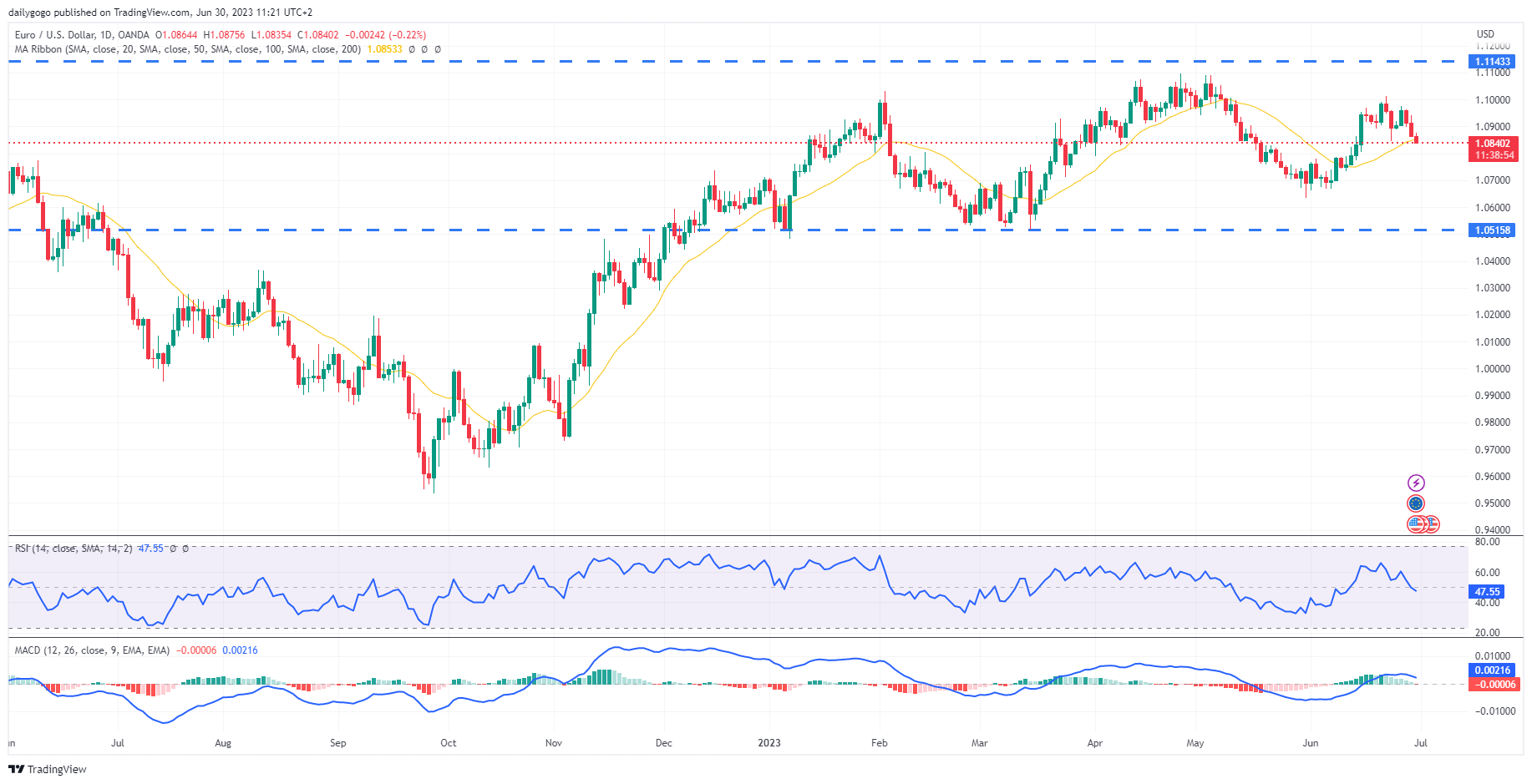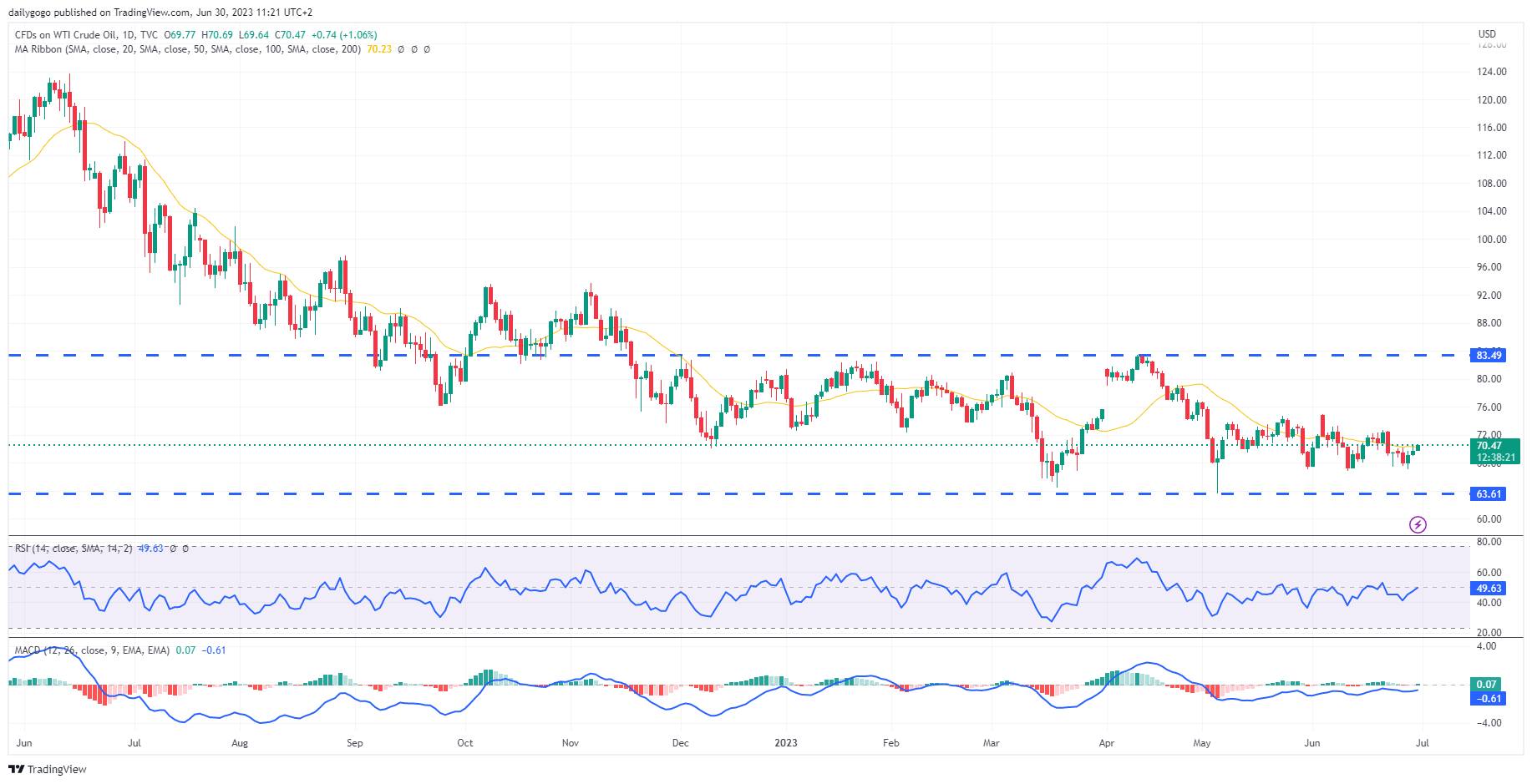EURUSD
- EUR/USD fell 0.08% to 1.0854 ahead of the release of the June consumer price index, indicating a cautious stance among traders as they await data on inflation in the eurozone.
- European Central Bank (ECB) President Christine Lagarde's recent statements have solidified market expectations for a ninth consecutive interest rate hike in July, contributing to a hawkish sentiment. This outlook is anticipated to drive gains of approximately 1.7% for the euro against the U.S. dollar throughout the month.
- The U.S. dollar stabilized in early European trade on Friday but is expected to record strong quarterly gains. Traders are anticipating further interest rate hikes by the U.S. Federal Reserve as the year progresses, supporting the dollar's strength against other currencies.
- Communication from central banks at the Sintra conference in Portugal has maintained a predominantly hawkish tone. The key message conveyed is that economies with low unemployment rates have been able to withstand significant tightening cycles, resulting in inflation remaining more resilient than anticipated.
- Overall, the EUR/USD pair is currently experiencing a slight decline, with market focus shifting towards upcoming economic data releases and the potential impact of interest rate decisions by the ECB and the Federal Reserve on the currency pair's dynamics.
Closing statement: EUR/USD faced a modest decline ahead of the release of the eurozone's June consumer price index. The hawkish stance from ECB President Christine Lagarde has reinforced expectations for an upcoming interest rate hike, driving projected gains for the euro against the U.S. dollar. Meanwhile, the U.S. dollar is stabilizing as traders anticipate further rate increases by the Federal Reserve. The Sintra conference emphasized the positive relationship between low unemployment rates and inflation, highlighting the potential resilience of economies to tightening monetary policies. So, as you move forward, remember that every ending is a new beginning, and every closed door opens up a world of possibilities.
GBPUSD
- GBP/USD rose 0.2% to 1.2633, positioning sterling for a monthly gain of 1.4%, despite weak first-quarter gross domestic product (GDP) growth of only 0.1% on the quarter.
- Traders are still pricing in additional rate hikes from the Bank of England (BoE) despite the sluggish economic growth. This is driven by the country's high inflation rate of 8.7% in May, which remains the highest among major advanced economies.
- The Dollar Index, which measures the dollar against a basket of six other currencies, traded slightly higher at 103.414. It is poised to record a gain of approximately 0.7% in the second quarter.
- Recent data released on Thursday revealed that the U.S. economy experienced stronger growth than initially estimated in the first quarter, while jobless claims data indicated a resilient labor market.
- Overall, GBP/USD has witnessed a modest increase, with sterling set to achieve a monthly gain despite weak GDP growth. The expectation of further rate hikes by the BoE, driven by high inflation, has supported the pound. Meanwhile, the U.S. dollar has remained relatively stable, benefiting from positive economic indicators.
| SMA (20) | Slightly Rising |
|
||
| RSI (14) | Neutral | |||
| MACD (12, 26, 9) | Slightly Falling |
Closing statement: GBP/USD registered a 0.2% rise, with sterling on track for a monthly gain despite sluggish GDP growth. The Bank of England's potential rate hikes are being factored in by traders due to the country's persistently high inflation rate. The Dollar Index is trading marginally higher and is anticipated to record a quarterly gain. The U.S. economy demonstrated stronger-than-expected growth in the first quarter, while jobless claims data signalled a robust labour market. Embrace the unknown with courage and curiosity, for it is through exploration that we find new avenues for growth and prosperity.
GOLD
- Gold prices showed little movement on Friday and were grappling with significant losses for the month of June. This was primarily driven by strong U.S. economic data, which increased risk appetite and raised concerns about potential interest rate hikes by the Federal Reserve.
- Despite a brief recovery from the lows, spot gold remained near the threshold of entering the $1,800s after reaching as low as $1,891 on Thursday.
- Federal Reserve Chair Jerome Powell has consistently communicated the likelihood of the U.S. central bank resuming its cycle of raising interest rates, as evident from his recent statements, including those made at the European Central Bank's annual gathering in Portugal.
- The upcoming release of the personal consumption expenditures index, the Federal Reserve's preferred measure of inflation, is of significant focus. The index is expected to show stability in May compared to the previous month. This could add pressure on the Fed to maintain higher interest rates in order to address persistent inflationary pressures.
- Overall, gold prices have experienced limited movement, with June marking a period of notable losses. The strong U.S. economic data and indications of potential interest rate hikes by the Federal Reserve have dampened investor sentiment towards gold. The forthcoming release of inflation data will play a crucial role in shaping market expectations regarding the Fed's monetary policy decisions.
| SMA (20) | Slightly Falling | |||
| RSI (14) | Slightly Falling | |||
| MACD (12, 26, 9) | Falling |
Closing statement: Gold prices remained relatively stagnant on Friday, reflecting significant losses for the month driven by robust U.S. economic data. Concerns about future interest rate hikes by the Federal Reserve have contributed to the subdued performance of gold. The focus now turns to the release of the personal consumption expenditures index, which could influence the Fed's decision-making regarding interest rates as they aim to manage inflationary pressures. Like the ebb and flow of the markets, life presents us with highs and lows, but it is how we navigate these fluctuations that define our path.
CRUDE OIL
- Crude oil prices experienced a slight increase on Friday, with Brent crude set to record its first monthly gain of the year. This was driven by a significant drawdown in U.S. oil inventories, which outweighed concerns over potential negative impacts on fuel demand from upcoming interest rate hikes.
- The U.S. Energy Information Administration (EIA) reported a substantial drop of 9.6 million barrels in crude oil inventories for the week ending June 23. This figure far surpassed the 1.8-million-barrel draw forecasted by analysts in a Reuters poll, raising concerns about tightening supply.
- In addition to the favourable inventory data, Saudi Arabia announced plans to further reduce output by 1 million barrels per day in July. This decision aligns with the broader OPEC+ agreement to limit oil supply until 2024.
- Refinitiv data revealed that Russia's seaborne oil exports from Primorsk, Ust-Luga, and Novorossiisk are expected to decline to 1.9 million barrels per day (bpd) in July, compared to 2.3 million bpd in June. This decrease is due to increased domestic refinery operations, which could contribute to further tightening of global crude oil supply.
- Overall, the combination of a significant drawdown in U.S. oil stocks, Saudi Arabia's planned output cuts, and reduced Russian seaborne exports indicates potential tightening in the global crude oil supply. These factors have contributed to the upward momentum in crude oil prices and the likelihood of Brent crude recording its first monthly gain in the year.
| SMA (20) | Neutral | ||
| RSI (14) | Slightly Rising |
|
|
| MACD (12, 26, 9) | Neutral |
Closing statement: Crude oil prices rose slightly on Friday, supported by a substantial drawdown in U.S. oil inventories and expectations of further supply reductions by Saudi Arabia. The market remains concerned about tightening global supply as evidenced by the strong U.S. economic data, the OPEC+ agreement, and the decline in Russian seaborne oil exports. These factors have outweighed worries about potential impacts on fuel demand from future interest rate hikes. As we part ways for now, I leave you with this thought: Embrace the journey, for it is through the twists and turns that we discover our true potential.
DAX
- Germany stocks closed lower on Thursday, with losses primarily driven by the Construction, Media, and Financial Services sectors.
- At the end of the trading day in Frankfurt, the DAX index declined by 0.01%, while the MDAX index decreased by 0.10%, and the TecDAX index fell by 0.02%.
- Among the best performers on the DAX, Dr Ing hc F Porsche AG Preferred experienced a rise of 2.70%, followed by Commerzbank AG O.N., which added 1.63%, and Infineon Technologies AG NA O.N., which was up 1.57% in late trade.
- On the other hand, the worst performers on the DAX included Vonovia SE, which fell by 2.58%, Covestro AG declining by 2.21%, and Brenntag AG decreasing by 1.79%.
- Recent inflation data releases across Europe have impacted market expectations. The June Eurozone core inflation rate is anticipated to be 5.5% YoY, representing an increase from May's 5.3%. This data may influence market pricing, potentially leading to expectations of a 25-basis point hike by the European Central Bank in both July and September.
| SMA (20) | Neutral | ||
| RSI (14) | Rising |
|
|
| MACD (12, 26, 9) | Neutral |
Closing statement: Germany's DAX index closed lower on Thursday, primarily driven by losses in the Construction, Media, and Financial Services sectors. While some stocks experienced gains, such as Dr Ing hc F Porsche AG Preferred and Commerzbank AG, others, including Vonovia SE and Covestro AG, saw declines. Market focus remains on inflation data releases, with expectations of an increase in the June Eurozone core inflation rate. These data points may impact market pricing and lead to expectations of interest rate hikes by the European Central Bank in the coming months. In the face of uncertainty, it is important to embrace the power of perseverance and the belief that every setback is merely a steppingstone to success.




